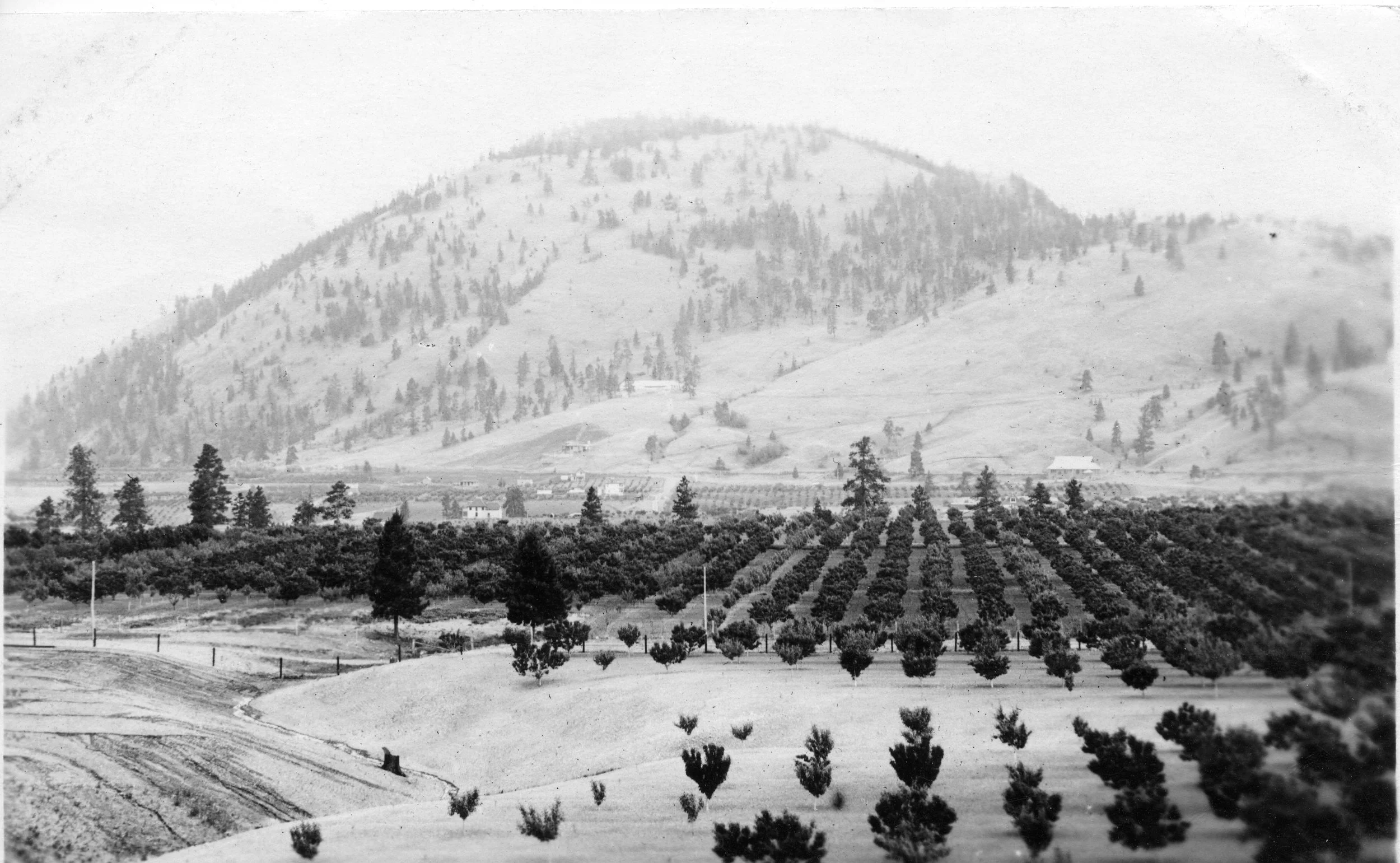Located on the shores and benches above Okanagan Lake, the mild climate and fertile soil of Summerland made it an attractive location for wealthy British investment.
The District of Summerland is centered around the downtown core and extends south to Trout Creek and back into four valleys: Garnett, Prairie, Peach, and Happy. The District is situated on the unceded and ancestral territory of the Syilx people of the Okanagan Nation.
Early history
The Syilx people’s traditional territory covers an area of over 69,000 square kilometers, stretching north to present-day Revelstoke and south into Washington State; however, the boundary of land often fluctuated. Their traditional lifestyle revolved around seasonal resources, such as the fall salmon run at the present-day Okanagan Falls and the bitterroot that was common in present-day Summerland.
Close up profile of Giant's Head Mtn, 1986-005-011
The Syilx people first interacted with European people through the fur trade. Fur brigades passed through the Okanagan area traveling from the south towards Fort Alexandria on the Fraser River. The Syilx people participated in the fur trade largely in the sale and trading of horses. The Okanagan Fur Brigade Trail had been used for an estimated 6000 years by the Sylx people but between 1811 and 1846 it was also frequented by fur traders working for companies such as the Pacific Fur Company, the North West Company, and Hudsons Bay Company. In 1845 the first non-Indigenous settlement in the Okanagan was established at Garnett Lake as an encampment on the Brigade Trail. Priest Camp was in use for 15 years before Father Pandosy founded the Mission in Kelowna. In 1998 the District of Summerland recognised the significance of Priest Camp by creating a fifty-acre Priest Camp Historic Park. The Fur Brigade Linear Park was then created in 2006, protecting it with the Heritage Conservation Act. This is the only preserved encampment and trail site of the historic Okanagan Brigade Trail.
By the mid-nineteenth century, the fur trade was slowing down; however, the discovery of gold in the Fraser Canyon in 1857 prompted an influx of newcomers, mostly Americans, who in subsequent years steadily raked through the valleys of British Columbia in search of the next big strike. Some of these newcomers turned to ranching or farming to find their fortune, and pressure began to grow from settlers who wanted to acquire the fertile land of the Okanagan Valley from local Indigenous people. A series of oral agreements were made with Syilx groups; agreements which were later broken as white settlers gradually acquired land in what is now known as the Summerland District. (Read more about the acquisition of land from Indigenous groups HERE.)
Settlement Begins
Prairie Valley looking west before orchards were planted, 1978-128-001
Much of the land around Summerland was acquired by white settlers through a process known as pre-emption. Similar to squatters rights, pre-emption allowed an individual to receive full title to a section of land by living on it for six months of every year for three years, building a house, and making other improvements. There were various pre-emptions in the area, even before the land was officially opened to the practice. A white family could pre-empt up to 320 acres, and it was on pre-empted land that the first commercial orchard was begun in 1888. News steadily spread about both the mild climate of the area and its potential for fruit farming ventures.
The name “Summerland” appeared in 1902 with the opening of a post office on the shores of Lake Okanagan. The following year, the Summerland Development Company was formed to build a townsite on the lakeshore, now known as “Lower Town.” The Company was primarily controlled by Sir Thomas Shaughnessy, the president of the Canadian Pacific Railway (CPR), who wanted to develop land in the interior of British Columbia to grow fruit for the growing CPR transportation and hotel chain. Shaughnessy took a personal interest in the area and formed the Summerland Syndicate to purchase land, encourage investment from his business friends, and actively promote the benefits of fruit farming to potential settlers.
A Growing Population
The settlers targeted by resulting advertising campaigns were of a very particular type. Old time ranchers, English aristocracy, and retired military men were preferred; both for their social standing and for their ability to start an orchard and live for eight to ten years before that orchard became viable. Fears of attracting a “criminal element” meant that people in Summerland discouraged the arrival of remittance men: young Englishmen from wealthy families who received money each month to stay away from home. Despite discouragement, several of the original settlers were remittance men, such as Barclay, Faulder, Turner, Morgan, and Fosbery, just to name a few!
Lower Town looking south towards Trout Creek c.1912, 1978-122-001
The involvement of the Summerland Development Company made the new town a wealthy one. The wealth of the CPR executives who bought fruit ranches in Summerland also made the town progress quickly. The Company provided various amenities to the lakeshore town, and by 1905 residents had water, septic tanks, electricity, a school, and a sawmill. Not only was the town the first in the Okanagan to enjoy electricity, it was also the first to have telephone service starting in 1907. Additionally, the town played host to the first College in the province when Okanagan College opened in 1906. A large fire in Lower Town in March 1922 accelerated the move of many businesses from Lower Town to the flats on the hills above, then known as West Summerland, which became the current downtown core.
Train over Trout Creek Trestle, 1976-179-001
The completion of the Kettle Valley Railway in 1916 opened up the area to the coast and the rest of Canada, which was especially important for access to fruit and poultry markets. Even with the railway, orchard owners were forced to negotiate problems of high shipping costs, markets glutted with early-ripening fruit from the United States, and the difficulties of shipping a highly perishable food in the days before refrigerated shipping.
To help aspiring farmers and orchardists, many of whom had little experience with the practicalities of fruit farming, the Dominion Experimental Farm was opened near Summerland in 1914. The main objectives of the research facility were to determine which crops, crop varieties, and breeds of livestock were best suited to the area. However, over the years the farm opened departments for Plant Pathology (1921) to investigate ways to mitigate disease outbreaks and Food Processing (1929) to determine more efficient ways to process fruit (such as dehydration) and to ship with minimal spoilage. For example, the entire process of manufacturing commercial fruit leathers, as well as the dryers used in the process, were developed at the Summerland Research Station.
As fruit trees matured and new markets were sought, packinghouses began to appear on the lakeshore. Although originally independent, high production, low prices, and inefficient transportation gave rise to co-ops. Packinghouses were joined by canneries and other industries related to fruit growing. Together, these were the major employers in the Summerland area. The first winery opened in 1981 at Sumac Ridge, and grape growing joined apples and stone fruits as a major Summerland crop.
In 1996, the Summerland Municipal Council adopted a bylaw that created a Tudor theme in the downtown business area, inspired by the already existing design of the Bank of Montreal. The Summerland District currently has a population of around 12,000 (2016) and is known for its fruit production, wine tours, beaches, and being home to the last remaining stretch of the Kettle Valley Railway.
B.C. Fruit Packers Co-op, packing apples c. 1949, 1976-359-001
A brief timeline
1826 - Nicola Prairie mentioned in fur trade journals
1827 - Nicola Prairie identified on McDonald map
1845 - Settlement of Priest Camp established
1857 - Gold discovered in the Fraser Canyon
1888 - First commercial orchard in the district opens
1902 - The Summerland post office opens
1906 - Municipality of Summerland is incorporated
1910 - First cannery opens
1914 - Dominion Experimental Farm established
1916 - Kettle Valley Railway is completed
1922 - Large fire in Lower Town encourages move up onto the flats (West Summerland)
1981 - First winery opens
1989 - Last train runs on the Kettle Valley Railway
1995 - Kettle Valley Steam Railway Society reopens local railway
1996 - Summerland establishes sister city with Toyokoro Japan
2007 - Summerland establishes friendship city with Kahama Tanzania
2007 - Summerland establishes friendship city with Santa Cruz del Norte, Cuba






